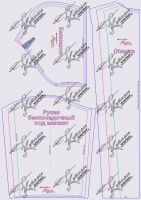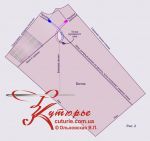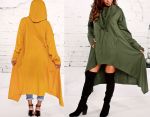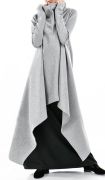Size charts What is the height of the pattern Payment methods Ask a question Reviews
PDF pattern for printing in full size on sizes 40 to 64.
How to sew a dress with two types of sleeves and hoods according to a pattern for beginners
Read this guide:
- Description of the pattern and what is included in the kit.
- Description of the design of the style.
- What to sew a gown with hooded sleeves from and how to calculate fabric consumption.
- How to buy, download and print patterns for sewing a dress.
- Features of a do-it-yourself pattern of a hoodie mantle dress (with a hood).
- How to sew a mantle dress with your own hands at home step by step.
Buy and download this dress pattern
Description of the pattern and what is included in the kit
 Electronic pattern of a dress of a mantle of a trapezoid with two types of hoods and sleeves 40-64
Electronic pattern of a dress of a mantle of a trapezoid with two types of hoods and sleeves 40-64
Sizes: 40-64 - the buyer receives all sizes.
File format for download in order:
PDF in full size and without seam allowances.
After paying for the order, you will receive links to download two files patterns of a dress of a mantle of the specified gradation of sizes:
- PDF A4 file adapted for printing patterns on sheets of A4 paper in any program on any device, including mobile phones.
- Multi-format PDF file for printing on sheets of any size from A0 to A4 on a printer or plotter using Adobe Reader.
Sewing Difficulty Level: Easy - you will need confident knitting skills, an overlocker with a knitted stitch and a machine with an adjustable zigzag.
The pattern is designed for sewing with your own hands at home on household sewing machines.
 Complete set of patterns for this dress
Complete set of patterns for this dress
- Back pattern.
- Shelf pattern.
- Pocket pattern.
- Barrel pattern.
- Sleeve patterns:
- pattern of a wide non-stop sleeve.
pattern of narrowed sleeves for a dress. - Patterns of hoods (hoodie):
- standard hood;
- hood-collar.
 If cuffs are required, they are cut out like a rectangle, so the calculation of the dimensions of this part is given below.
If cuffs are required, they are cut out like a rectangle, so the calculation of the dimensions of this part is given below.
Description of the style design
The pattern of this dress with a hood, despite the apparent intricacy, has a very concise design (picture 2).
Stitching the seams of the reliefs, you will see a quadrangle.
The side line of the dress here is closer to the diagonal than to the sides of the resulting figure.
 This form makes the mantle virtually dimensionless, so the size is chosen, based on the desired shoulder size and sleeve width.
This form makes the mantle virtually dimensionless, so the size is chosen, based on the desired shoulder size and sleeve width.
The advantages of such designs are obvious - the dress is suitable for a figure of any height with any features.
Correction of the length "in a straight line" is another advantage of the style. To change the length, fold the patterns as shown in 2 drawing and lengthen or shorten along the bottom lines.
You can easily lengthen only in front in a straight line or shorten only in the back, also in a straight line.
Sleeves in a set of dress patterns - non-stop, that is, the length of the eyelet is distributed evenly along the armhole. If desired, you can narrow the sleeve along the arm and plant (stretch) the armhole by stitching it.
Hoods designed for a drawstring (tie on a cord). Hood-collar - more like a collar-collar and it will need to be laid out on the figure when worn.
What to sew a mantle dress with hooded sleeves from and how to calculate fabric consumption
 For sewing, it is worth using thin and medium-thick knitted fabrics.
For sewing, it is worth using thin and medium-thick knitted fabrics.
An ordinary cooler fabric (cooler, fabric for sewing T-shirts), not a thick footer with an underside of eyelets or with a very thin fleece will do.
Fleece will work too.
Jersey is also suitable.
For cuffs, you can use cuff fabric.
The fabric consumption will be, depending on the width and size, 230 - 330 cm.
 To calculate the fabric consumption accurately, you need
To calculate the fabric consumption accurately, you need
- Decide on the width of the fabric. The width of the cooler can vary from 160 to 190, the width of the footer is on average 180 cm, and the width of jersey and other types of knitwear is 140 - 150 cm. Therefore, the first step is to find out the exact width of the fabric.
- Choose the size of the pattern, as well as decide on the length of the sleeve and the length of the product.
- Decide on a variation of the style and sewing technology. The most important question is whether the hood will be double. This choice depends on the thickness and looseness of the fabric, as well as on your desire. For example, when sewing from a thin cooler or other thin knitwear, you can choose a double hood or a single one, but if you sew from a footer or fleece, a single one or with a thin lining is better.
- After going through the first three steps, lay out the patterns "on the fabric" and get a very accurate consumption. How to lay out the patterns on the fabric is described below.
How to buy, download and print dress patterns
How to choose a size without using tables and taking measurements.
How to buy and download a ready-made electronic pattern.
How to print a pattern at home in full size on A4 sheets or on sheets of any other size.
How to assemble a pattern after printing.
Ready-made patterns of dresses and sweatshirts in full size download for free.
Buy and download this dress pattern
Features of a pattern with your own hands of a hoodie mantle dress (with a hood)
Notches and other sewing wisdom
 Since, when calculating the exact consumption of fabric, you corrected the length of the patterns and decided on the style option, the main difficulties are already behind you.
Since, when calculating the exact consumption of fabric, you corrected the length of the patterns and decided on the style option, the main difficulties are already behind you.
Seam allowances are not required for this model, but for ease of sewing, notches are needed to limit the entrance to the pocket and separate the relief from the armhole. You will also need a notch at the seam point of the sleeve along the armhole line.
The length of the notch is 0,5 cm, that is, it should not exceed the width of the knitted overlock seam. All notches are marked on the pattern drawings.
What is a knitted seam and how not to confuse it with an overcast overlock seam ...
Layout options for cutting a mantle dress with your own hands
Let's dwell on the most likely layouts for do-it-yourself patterns (drawings 3 и 4).
On the 3 drawing a variant is shown in which the back and side are combined. Such a combination of parts can be done if the width of the fabric allows.
Pay attention to the hood: in this case it is single and, in order to avoid a seam in the most visible place in front, the hood is laid on the fold of the fabric with a line that corresponds to a half-skid.
 The drawstring is essentially a double hem with holes for the lace. An allowance for it can be added or not added, depending on how deep you want to see the hood.
The drawstring is essentially a double hem with holes for the lace. An allowance for it can be added or not added, depending on how deep you want to see the hood.
If the width is smaller or larger, the layout may look similar to the layout shown in 4 drawing. Here the double hood has a fold along the line of the face. This makes it easier to process the drawstring - holes plus one line.
The dimensions of the cuff from the "cuff" ("dovyaz") are determined by the wrist and the width in finished form.
Cut-to-length cuff width = 2 finished widths + 2 cm
Cut-out cuff length = Wrist girth + 2 cm
The length of the cuff can be measured directly on the arm.
How to sew a mantle dress with your own hands at home step by step
- We start with the pocket.
We put one of the details of the pocket face to face on the shelf and grind along the segments of the entrance to the pocket from notch to notch.
You can stitch with a narrow zigzag. We twist, iron, give a finishing line from notch to notch.
We iron again.
Along the horizontal cuts, we grind two pieces of burlap on an overlock, and at the bottom we also add a narrow zigzag for strength.
We iron, fix the upper cut of the burlap with a finishing line along the shelf.
We iron and the pocket is ready. - We grind the seams of the hood, iron it, process the drawstring, as described above.
- We grind the relief seams and the seam of the sleeve with a pass for the finger with a knitted seam, ironed. We sew a hole for the finger with a narrow overcasting seam or a rolled seam.
- We pin off the armhole and sleeve.
The first pin connects the notch and the seam.
Then, divide in half, folding the sleeve and armhole, we cut off the middle point.
Then, we cut off the middle points between the two pins.
We sew the sleeve into the armhole on the overlock with a knitted seam. - The hood is sewn in, like the sleeve - first we cut off the middle points of the hood and neck with pins, then the middle points between them ...
- We process the bottom into a hem with an open cut - overcast and fold once, or hem with a double needle, or with a stitching seam.
But the easiest way is a narrow overlock seam or a rolled seam for thin fabrics.
Download this pattern pdf:
A-line dress-mantle pattern with two types of sleeves and hoodies
$2.00 (80 hryvnia)
Bank cards of the Russian Federation are not accepted for payment!
Size charts What is the height of the pattern Payment methods Ask a question Reviews
Vera Olkhovskaya in social networks:

See similar clothing patterns and how to sew on them
-
Any pattern for free for a review of a previously made order
More...
Lifetime promotion for buyers of patterns!

Leave a review about my store of patterns for an order that you made before, and you will receive any paid pattern of your choice Free!


























